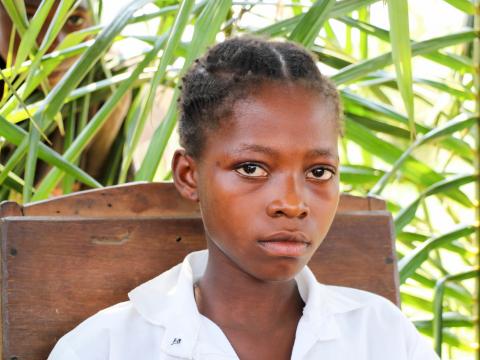A future chief in Kasais | Marie's story

Marie, 11, wants to grow up to become a local village chief. Although female chiefs are somewhat common further South in the Democratic Republic of Congo, the Kasais are widely patriarchal, and it would be especially uncommon to have a female chief here.
She may be smaller than a lot of the other girls in her class, but to take her soft-spoken nature at face value would be to seriously underestimate her. Despite the upheaval of the past year, Marie and her parents are determined for her to pursue her dreams.
When a local chieftaincy conflict hundreds of kilometres away spilled over to her home district of Kamonia in Kasai Province this spring, Marie and her family fled. Her brothers stopped in Kananga, the regional capital of Kasai Central, while Marie, her little sister, and parents carried on to Kazumba, where her aunt lives, another two hours away from Kananga.
“My family came from Kasai,” Marie told me. “The military came into our family and took everything. We fled the conflict there and came here, but when we arrived here we found conflict again. We fled to the bush and stayed there for a month. We only really came out in July.”
“The past year has been terrible,” Marie explained. “All the things that happened…we’ve lost a year. We weren’t able to study. I should have been in secondary school now, but with everything that happened we kept having to stop classes and flee.”
Thankfully, peace has more or less come to the Kasais since this summer, and schools finally reopened again in mid-September. However, even schools didn’t escape the violence unscathed. In Marie’s school district of Kazumba Nord, 44 schools were burnt or destroyed. Thankfully, Marie’s new school isn’t one of them.
“I’m happy here now.” She smiles. “I prefer it, the schools are better here than in Kamonia. It was important to my father for me to go back to school when we got here to Kazumba.”
And although it’s taken six months, she finally is. Even though she has to redo her last year of primary school, Marie is determined not to let it hold her back.
If she can’t become a chief when she grows up, she wants to be a headmistress. “Headmistresses are respected,” she said. “And it’s a good job, where you’ll have enough to eat. I’m going to follow my parents’ advice so I can finish school, and pursue my studies all the way until the end.”
World Vision declared a Category III National Emergency in the Kasais in June 2017, and has been targeting 146,000 beneficiaries in the Grand Kasai region, as well as refugees who’ve fled to Angola. Initial interventions focus on food and child protection, with a fundraising goal of 2million USD.
Working with World Food Programme we have distributed foodstuffs to more than 28,000 food insecure people in Kasai Central – these were the first food distributions in the region since the crisis began. From 12 October we will start a new wave of food distributions with WFP to provide a further 75,000 individuals with supplies through November. In the realm of child protection and education, WV is opening six Child Friendly Spaces, conducting back to school distributions of bags and supplies, and planning education interventions which will reach over 30,000 children affected by the conflict.